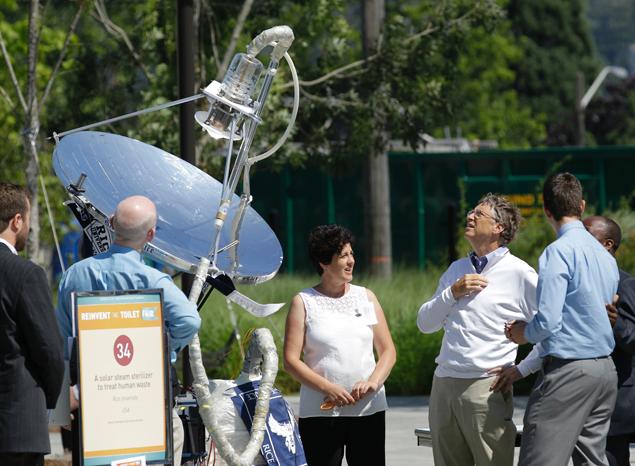We have all been known to flush a little money down the toilet. But when Bill Gates does it, it’s actually a good thing.
Probably the geekiest science fair ever, The Reinvent the Toilet fair took place on its Seattle campus this week. The competition was hosted by the Bill & Melinda Gates Foundation as a step towards developing a toilet for the 2.5 billion people around the world who do not have access to today’s contemporary sanitation systems. The challenge: the toilet of the future must function sans running water, electricity or a septic system, cannot emit pollutants, and most importantly runs cheaply: on about 5 cents per day.
The fair featured some down and dirty W.C. designs – 28 of them – including one that utilized microwave energy to turn poop into electricity, another into charcoal, and yet another that made use of urine for flushing. Another toilet, led by a team of London scientists at the School of Hygiene and Tropical Medicine, boasted a design that used black soldier fly larvae to process human waste and simultaneously create environmentally-friendly animal feed.
The winner, however, was the California Institute of Technology took the first-place prize of $100,000 with a solar-powered toilet that generated hydrogen gas and electricity, a design run by Prof Michael Hoffman.
“We couldn’t be happier with the response that we’ve gotten,” Bill Gates said at the event.
Bill Gates’ new project, to which he has invested $370 million, is a winner in itself for many reasons. Today’s impractical toilet systems waste tons of drinkable water. Furthermore, the UN has assessed that illness and disease as a result of unsanitary conditions is responsible for 50% of the hospitalizations that occur each year. Every year, 1.5 million kids die from diarrheal disease.
The Bill & Melinda Gates Foundation hopes to field-test the prototypes from the Reinvent the Toilet Fair within three years, most of which turn solid waste into energy which could improve sanitation systems around the globe, resulting in a higher quality of life for many, as well as a boosted environment.
“If we do it right,” said Gates, “there’s every possibility that some of these designs would also be solutions for rich and middle-income countries.”


